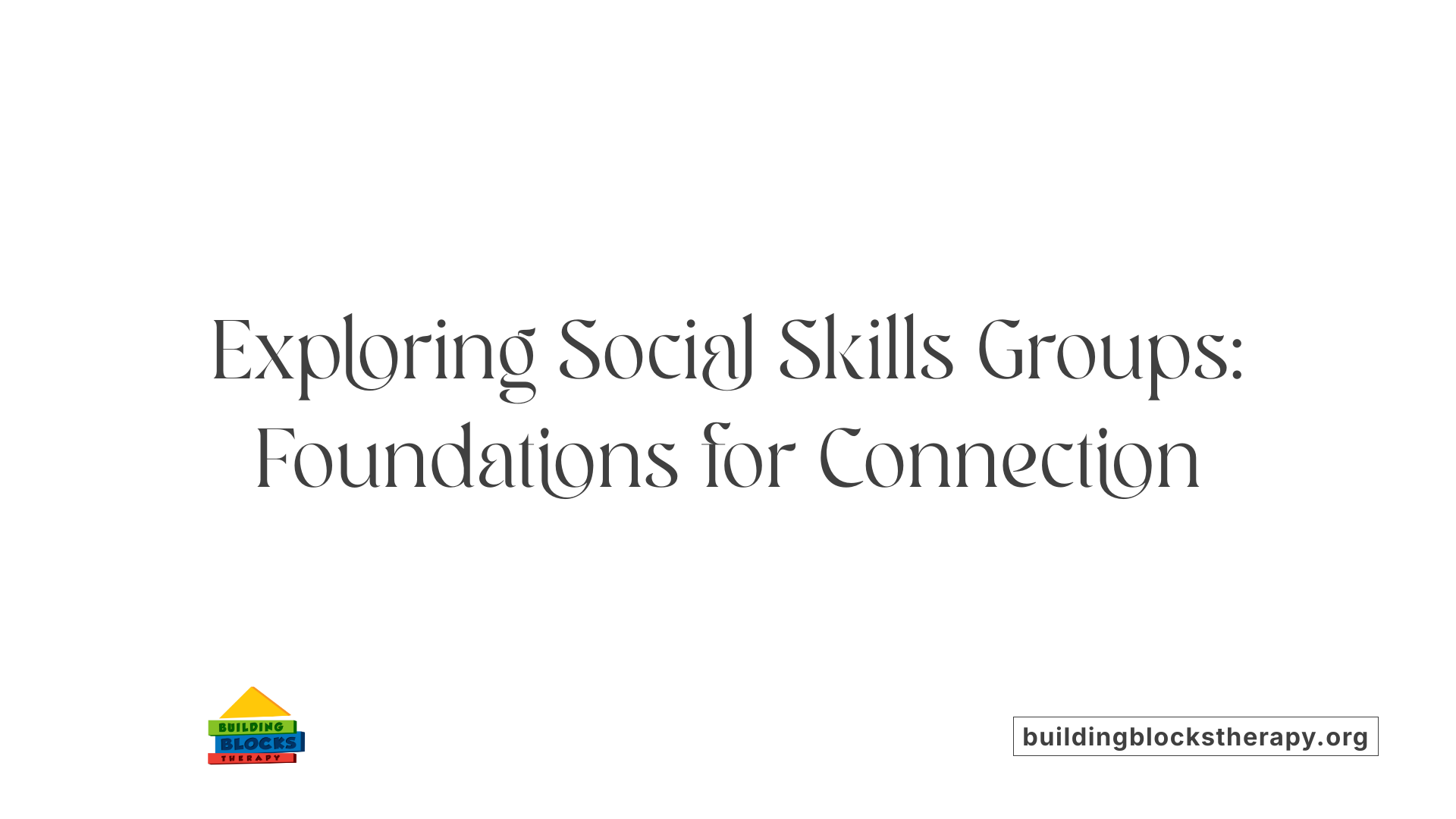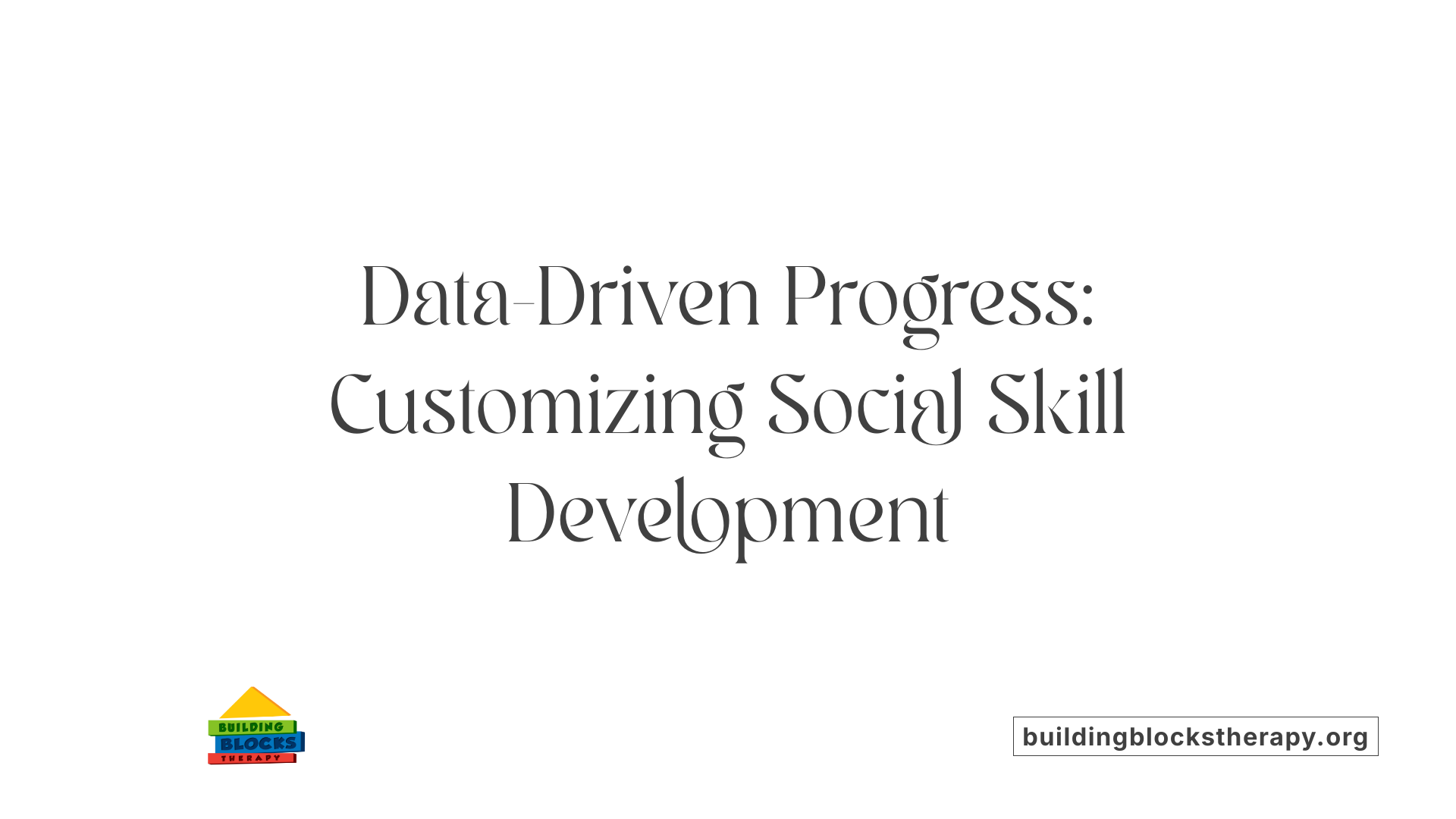The Role of Social Skills Groups in ABA Therapy
Enhancing Social Development Through Group-Based ABA Interventions

Understanding the Intersection of ABA Therapy and Social Skills Groups
Applied Behavior Analysis (ABA) therapy is a leading evidence-based approach for supporting children with autism spectrum disorder (ASD) in developing essential social skills. Integral to these interventions are structured social skills groups that provide a collaborative environment where children can practice and refine social behaviors. This article explores the role these groups play within ABA therapy, detailing their principles, methodologies, and the benefits they bring to social development for children with autism.
Fundamentals of Behavioral Therapy for Autism

What is behavioral therapy and how does it help individuals with autism?
Behavioral therapy for autism, primarily through Applied Behavior Analysis (ABA), is a scientifically validated approach that uses principles of learning and environmental influence to improve specific skills and behaviors. It employs techniques such as positive reinforcement and the antecedent-behavior-consequence (A-B-C) model to encourage desirable behaviors like communication, social interaction, and daily living skills, while reducing challenging behaviors.
Role of ABA in autism treatment
ABA serves as the foundation of behavioral therapy for autism. It is tailored through comprehensive assessments to identify each individual's unique strengths and social skills needs. ABA techniques, including shaping, task analysis, and natural environment training (NET), progressively build social abilities by reinforcing incremental improvements. This personalized focus ensures that interventions target meaningful, measurable goals for each child.
Methods used in behavioral therapy
Several proven methods comprise behavioral therapy for autism:
- Discrete Trial Training (DTT): Breaks social skills into manageable parts for focused practice and mastery.
- Pivotal Response Training (PRT): Enhances motivation and communication attempts using preferred activities.
- Role-playing and Modeling: Provide safe opportunities to practice social interactions and understand non-verbal cues.
- Natural Environment Teaching (NET): Applies skills in everyday, real-world settings to enhance generalization.
- Social Stories: Use narratives to clarify social expectations and promote appropriate responses.
- Peer-mediated Interventions: Incorporate typically developing peers to model and practice skills.
Goals and outcomes of therapy
The ultimate aims of behavioral therapy include improved social communication, emotional understanding, and the ability to form positive relationships. Progress is data-driven, monitored through detailed observation and tracking tools, often involving parents and caregivers to reinforce skills across settings. Effective therapy fosters better peer interactions, increased confidence, and greater independence, helping children with autism lead fuller, more connected lives.
Principles and Techniques Underpinning ABA Therapy
What are the core principles behind Applied Behavior Analysis (ABA) therapy?
Applied Behavior Analysis (ABA) is a scientifically supported approach that applies principles of learning and behavior to encourage positive behavior changes. At its core, ABA relies on analyzing the relationship between antecedents (what happens before a behavior), the behavior itself, and consequences (what follows the behavior), often referred to as the "A-B-C" model. This framework helps therapists identify what motivates or discourages certain behaviors.
Reinforcement is a fundamental principle in ABA, where desirable behaviors are encouraged by rewarding them, thus increasing the likelihood they will occur again. Conversely, extinction involves reducing undesired behaviors by withholding reinforcement. Shaping is another vital technique, involving reinforcing successive approximations toward a desired behavior, gradually building complex skills.
ABA therapy is tailored to each individual's needs through comprehensive assessments that pinpoint specific social skill deficits and strengths. This personalization ensures interventions are relevant and effective. For example, therapists may use prompting and fading to guide the child through new social interactions, with positive reinforcement encouraging continued progress.
Other common ABA techniques include task analysis (breaking down complex skills into manageable steps), modeling (demonstrating behaviors to imitate), role-playing, and natural environment training (learning skills in everyday settings). Social stories provide narratives to help children understand social cues and expectations.
Data collection and continuous progress monitoring allow therapists to adjust strategies based on the child's response, ensuring evidence-based and meaningful improvements in social communication, emotional understanding, and peer interaction.
Together, these principles and techniques enable ABA therapy to systematically develop social skills, boost confidence, and foster independence in children with autism spectrum disorder.
Who Provides Behavioral Therapy and How Is It Delivered?
What Types of Providers Are Involved in ABA Therapy?
Behavioral therapy for autism is typically provided by a team of trained professionals. The core experts are Board Certified Behavior Analysts (BCBAs), who develop and oversee individualized treatment plans based on detailed assessments. Implementation is often carried out by Registered Behavior Technicians (RBTs) or Behavior Technicians, who deliver therapy sessions under the BCBA's supervision.
What Are the Roles of BCBAs and RBTs?
BCBAs are responsible for designing tailored interventions that target specific social skills and behavioral goals. They conduct ongoing data collection and adjust therapy strategies to meet each child's unique needs. RBTs, under BCBA guidance, directly engage with the child during sessions using ABA techniques such as modeling, prompting, and reinforcement to teach and reinforce social skills and communication.
In What Settings Is ABA Therapy Delivered?
ABA therapy is delivered across multiple environments to promote skill generalization. Common settings include the child's home, schools, and community locations. Some providers also offer online therapy options to enhance accessibility. These varied settings help children practice social skills in natural surroundings, improving real-world application.
How Are Parents Involved and Trained?
Parental involvement is a critical component of ABA therapy. Providers often include parent training sessions that teach caregivers how to reinforce learned skills at home. This ongoing support empowers families to help maintain and generalize social behaviors outside formal therapy sessions.
Together, the collaborative efforts of BCBAs, RBTs, and parents create a comprehensive and flexible approach to maximize social skill development and behavioral progress in children with autism.
The Structure and Function of Social Skills Groups in ABA

What Are Social Skills Groups?
Social skills groups in ABA therapy are structured small-group settings designed to teach and practice social interaction skills. These groups provide a safe, supportive environment where children with autism can develop essential social abilities alongside peers.
How Does ABA Inform Social Skills Groups?
Applied Behavior Analysis principles are deeply integrated into these groups. Techniques such as task analysis, modeling, positive reinforcement, and role-playing form the core approach to teaching. Interventions are individualized based on comprehensive assessments, ensuring goals are meaningful and achievable.
What Activities Are Used During Group Sessions?
Activities like role-playing simulated social scenarios allow children to practice conversational skills, turn-taking, and recognizing non-verbal cues. Modeling by therapists and peers demonstrates appropriate social behaviors, while reinforcement encourages repeated positive interactions. Group-based problem-solving and friendship-building exercises foster collaboration and confidence among participants.
Why Is This a Safe Space for Practice?
Social skills groups create a controlled, judgment-free zone where children can try new social behaviors without fear of failure. The small size and systematic curriculum help maintain structure, while therapists closely monitor progress and provide immediate feedback. This setting encourages active participation and gradual skill mastery in a natural, yet supportive social context.
Key ABA Strategies Employed in Social Skills Groups

How Are Task Analysis and Discrete Trial Training Used?
Task analysis breaks down complex social skills into smaller, teachable steps, enabling children to learn one part of a skill at a time before combining them. Discrete Trial Training (DTT) applies this approach systematically through repeated practice and reinforcement, facilitating mastery of specific social behaviors like initiating conversations or recognizing nonverbal cues.
What Role Do Modeling and Role-Playing Play?
Modeling involves demonstrating appropriate social behaviors for children to imitate, helping them understand expected responses. Role-playing creates safe, structured opportunities for practice, allowing children to rehearse skills such as greeting peers or turn-taking. Both techniques use positive reinforcement to encourage repetition and gradual improvement.
How Do Peer-Mediated Interventions Support Learning?
These interventions incorporate typically developing peers who model social skills in naturalistic settings. Peers facilitate interactions by prompting and reinforcing positive behaviors, which promotes social understanding and engagement. This method helps children with autism practice skills in realistic social contexts within group settings.
Why Are Social Stories and Visual Supports Important?
Social stories use narratives to clarify social situations and expectations, enhancing a child's comprehension of social cues and emotions. Visual supports like schedules and cue cards improve understanding of group activities and transitions, reducing anxiety and improving participation. These tools complement direct teaching by reinforcing concepts visually.
Through these ABA strategies integrated in social skills groups, children with autism gain structured, evidence-based support to develop essential social competencies in a collaborative and supportive environment.
Generalization: From Group Sessions to Real-World Social Engagement

Why Is Generalization Important in ABA Therapy?
Skills learned in ABA therapy are most effective when children can apply them beyond structured settings like therapy rooms or small groups. Generalization ensures that social skills translate into real-life scenarios such as classrooms, playgrounds, and home environments. Without this transfer, social gains may remain limited to therapy, reducing overall impact.
Natural Environment Teaching (NET) as a Generalization Tool
Natural Environment Teaching (NET) emphasizes learning social skills in everyday contexts instead of artificial therapy settings. This strategy uses naturally occurring opportunities—like playing with siblings or interacting at school—to practice and reinforce behaviors. NET helps children understand when and how to use social skills spontaneously, making interactions smoother and more authentic.
The Role of Parents and Caregivers in Reinforcement
Involving parents and caregivers is crucial for reinforcing social skills outside therapy. They learn techniques to prompt and reinforce desired behaviors during daily routines and social activities. This consistent support helps children maintain and expand their skills across settings. For example, parents can help encourage turn-taking during family games or facilitate conversations with peers.
Overcoming Challenges in Applying Skills Beyond Therapy
Despite structured training, applying social skills outside of therapy can be challenging. Children might face unpredictable social cues or varying peer responses that are hard to simulate in sessions. Additionally, maintaining motivation across settings and managing co-occurring issues like anxiety can affect progress. ABA therapists address these hurdles through individualized plans, continuous data collection, and collaboration with families and schools. Incorporating real-world practice opportunities is essential for long-term success.
Addressing Common Challenges in Behavioral Therapy for Autism
Maintaining motivation and engagement over time is critical, as some children may become fatigued or disinterested. Challenges also include generalizing skills across environments and managing co-occurring conditions such as sensory sensitivities. Behavioral issues like tantrums or self-injury require careful assessment and intervention, emphasizing the need for collaboration among therapists, parents, and educators.
By integrating strategies like NET, actively involving caregivers, and acknowledging potential challenges, ABA therapy can help children with autism generalize crucial social skills from group sessions into real-world social engagement effectively.
Monitoring Progress and Using Data to Tailor Interventions

Importance of Data Collection and Progress Tracking
In ABA social skills training, systematic data collection is vital for understanding each child's developmental trajectory. Tracking progress allows therapists to assess how well the child acquires social skills such as initiating conversations, turn-taking, or recognizing non-verbal cues. Consistent measurement helps identify areas where the child excels and those requiring additional support.
Tools like Parental Portals
Innovative tools, including parental portals, enable caregivers to actively participate in monitoring their child's development. These digital platforms provide real-time access to progress reports, session notes, and skill assessments. Such involvement fosters collaboration between families and therapists, ensuring continuity of reinforcement practices beyond therapy sessions.
Adjusting Therapy Based on Assessment Data
Regular analysis of collected data guides therapists in fine-tuning intervention plans. For example, if a child struggles with generalizing social skills from group settings to natural environments, therapists might increase the use of Natural Environment Training (NET) or incorporate additional role-playing exercises. This responsive approach enhances therapy effectiveness by addressing individual needs dynamically.
Measuring Social Skills Improvement Over Time
Social skill development is monitored through measurable objectives outlined in individualized treatment plans. Progress is documented via direct observation and structured recording methods that capture gains in areas like emotional understanding, peer interaction, and conversational abilities. Over time, these metrics provide clear evidence of improvement and inform goal adjustments to support continuous growth.
Social Skills Developed Through ABA Group Therapy

What Social Skills Are Developed Through ABA Group Therapy?
ABA group therapy offers a structured environment where children with autism learn and practice essential social skills systematically. A foundational skill developed is reciprocal conversations—children are taught to initiate and respond appropriately in dialogues, thereby enhancing social communication. Alongside this, children build emotional understanding, learning to recognize and express emotions effectively.
How Are Nonverbal Cues and Turn-Taking Taught?
Recognizing nonverbal cues such as facial expressions and body language is vital for meaningful interaction. ABA uses techniques like role-playing and peer-mediated interventions in group settings to teach these skills. Children also practice turn-taking, crucial for conversational flow and cooperative play, through guided group activities that reinforce patience and respect.
How Does ABA Support Problem-Solving and Friendship Building?
Group sessions simulate real-life social environments, promoting problem-solving skills by encouraging children to navigate social challenges collaboratively. Activities focus on friendship building, active listening, and cooperation, creating a safe space where children practice initiating and maintaining positive peer relationships.
What Is the Impact on Confidence and Independence?
By systematically reinforcing positive social behaviors, ABA group therapy boosts children's confidence in social situations. These gains translate to greater independence, as kids become more adept at social interaction, self-advocacy, and navigating diverse social settings beyond therapy.
In summary, ABA group therapy fosters a range of interconnected social skills—from conversation and emotional comprehension to turn-taking and friendship—which collectively enhance confidence and functional independence in children with autism.
The Long-Term Benefits and Future Directions of ABA Social Skills Groups
Why is lifelong social skill development important in ABA therapy?
ABA therapy not only targets immediate improvements but also emphasizes the lifelong importance of social skill development for children with autism. By fostering effective communication, emotional understanding, and peer interaction early on, ABA prepares individuals for lasting positive connections, friendships, and greater independence. These skills contribute significantly to success in academic and vocational settings, laying a foundation for quality of life throughout adulthood.
How do ABA social skills groups enhance community integration and academic success?
Social skills groups create a supportive environment where children practice friendship-building, problem-solving, and active listening. These groups simulate real-world social interactions that help children generalize skills beyond therapy—into school and community settings. The ability to form peer relationships, engage collaboratively, and self-advocate promotes smoother transitions into mainstream classrooms and community activities, enhancing overall participation and academic achievement.
What emerging tools are advancing social skills development in ABA?
Innovations such as video modeling and virtual reality are revolutionizing ABA social skills training. Video modeling allows children to observe and imitate social behaviors through recorded scenarios, enhancing understanding and retention. Virtual reality creates immersive environments where children can practice social interaction in controlled, yet realistic settings, helping tackle unpredictable social situations they may face outside therapy. These emerging tools complement traditional methods, offering dynamic ways to engage learners.
How is collaboration shaping the future of ABA social skills interventions?
The future of ABA social skills training thrives on collaboration among therapists, families, and educators. Shared communication and coordinated efforts ensure consistent reinforcement of social skills across environments. Family involvement is crucial for practicing skills at home, while educators help integrate learned behaviors into academic routines. This triadic partnership maximizes the effectiveness of intervention, supports generalization of social skills, and fosters a comprehensive support system reinforcing children’s development.
| Aspect | Role | Impact |
|---|---|---|
| Lifelong Skill Development | Foundation for independence and success | Enables meaningful relationships and vocational achievements |
| Social Skills Groups | Safe space for practicing peer interactions | Improved community integration and academic participation |
| Emerging Tools | Video modeling and virtual reality for skill practice | Enhances engagement and real-life social preparedness |
| Collaborative Efforts | Therapist-family-educator partnerships | Consistent reinforcement and generalization of skills |
Bringing It All Together: The Impact of Social Skills Groups Within ABA Therapy
Social skills groups are a vital component of ABA therapy, providing children with autism a structured, supportive environment to learn, practice, and generalize critical social behaviors. Rooted in scientifically validated principles of Applied Behavior Analysis, these group interventions utilize a variety of evidence-based strategies—from role-playing to peer-mediated interactions—to enhance communication, emotional understanding, and social engagement. While challenges exist, particularly in generalizing skills beyond therapy sessions, collaboration with families and use of natural environment teaching techniques help overcome these hurdles. Ultimately, social skills groups within ABA therapy not only improve immediate social functioning but also set the foundation for long-term independence, better peer relationships, and enriched quality of life for children with autism.
References
- Working With ABA And Social Skills Groups For Autism
- Exploring the Role of ABA Therapy in Enhancing Social ...
- Building Social Skills Through ABA Therapy
- How ABA Therapy Helps With Social Skills
- How ABA Therapy Helps Improve Social Skills in Children
- Why Social Skills ABA Therapy Is Essential For Your Child
- ABA Therapy for Social Skills Development in Autism
- Applied Behavior Analysis (ABA)
- The Science of ABA: Understanding the Principles ...





